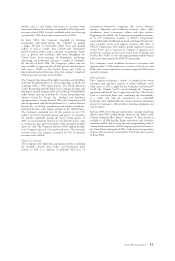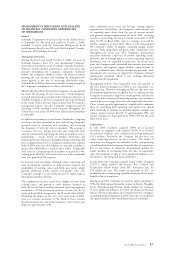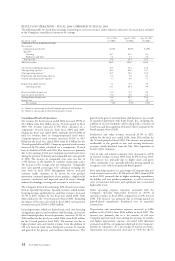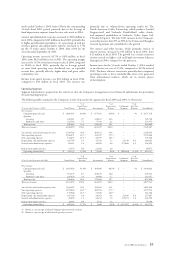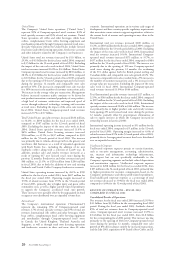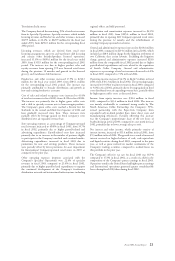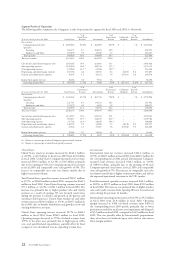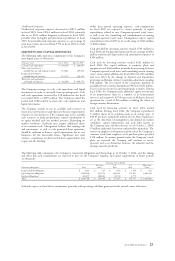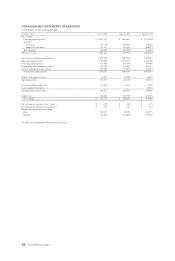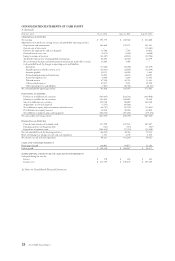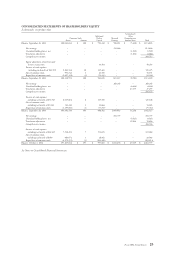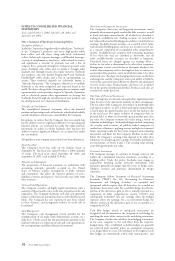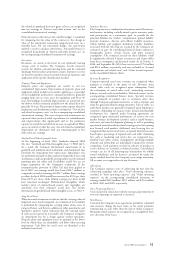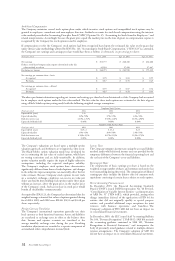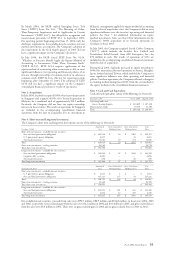Starbucks 2004 Annual Report Download - page 12
Download and view the complete annual report
Please find page 12 of the 2004 Starbucks annual report below. You can navigate through the pages in the report by either clicking on the pages listed below, or by using the keyword search tool below to find specific information within the annual report.
Fiscal 2004 Annual Report 23
Unallocated Corporate
Unallocated corporate expenses decreased to $187.3 million
in fi scal 2003, from $194.4 million in fi scal 2002, primarily
due to an $18.0 million litigation settlement in fi scal 2002,
partially offset by higher payroll-related expenditures in fi scal
2003. Total unallocated corporate expenses as a percentage of
total net revenues decreased from 5.9% in fi scal 2002 to 4.6%
in fi scal 2003.
LIQUIDITY AND CAPITAL RESOURCES
The following table represents components of the Company’s
most liquid assets (in thousands):
Fiscal year ended Oct 3, 2004 Sept 28, 2003
Cash and cash equivalents $ 299,128 $ 200,907
Short-term investments –
available-for-sale and trading securities 353,881 149,104
Long-term investments –
available-for-sale securities 135,179 136,159
Total cash, cash equivalents
and liquid investments $ 788,188 $ 486,170
The Company manages its cash, cash equivalents and liquid
investments in order to internally fund operating needs. Cash
and cash equivalents increased by $98 million for the fi scal
year ended 2004, to $299 million. The Company ended the
period with $788 million in total cash, cash equivalents and
liquid investments.
The Company intends to use its available cash resources to
invest in its core businesses and other new business opportunities
related to its core businesses. The Company may use its available
cash resources to make proportionate capital contributions to
its equity method and cost method investees. Depending on
market conditions, Starbucks may acquire additional shares
of its common stock. Management believes that existing cash
and investments, as well as cash generated from operations,
should be suffi cient to fi nance capital requirements for its core
businesses for the foreseeable future. Signifi cant new joint
ventures, acquisitions or other new business opportunities may
require outside funding.
Other than normal operating expenses, cash requirements
for fi scal 2005 are expected to consist primarily of capital
expenditures related to new Company-operated retail stores,
as well as for the remodeling and refurbishment of existing
Company-operated retail stores. Management expects capital
expenditures in fi scal 2005 to be in the range of $600 million
to $650 million.
Cash provided by operating activities totaled $794 million in
fi scal 2004 and was generated primarily by net earnings of $392
million and noncash depreciation and amortization expenses of
$305 million.
Cash used by investing activities totaled $632 million in
fi scal 2004. Net capital additions to property, plant and
equipment used $386 million, primarily from opening 634 new
Company-operated retail stores and remodeling certain existing
stores. Gross capital additions for fi scal 2004 were $434 million
and were offset by the change in disposal and impairment
provisions and foreign currency translation adjustments totaling
$48 million. The net activity in the Company’s portfolio of
available-for-sale securities during fi scal 2004 used $212 million.
Excess cash was invested in investment-grade securities. During
fi scal 2004, the Company made additional equity investments
of its proportionate share in a number of its International
investees and acquired a 49.9% interest in its Malaysia licensed
operations for a total of $65 million, excluding the effects of
foreign currency fl uctuations.
Cash used by fi nancing activities in fi scal 2004 totaled
$67 million. During fi scal 2004, the Company repurchased
5 million shares of its common stock at an average price of
$40.85 per share, using $203 million of cash. Share repurchases
are at the discretion of management and depend on market
conditions, capital requirements and such other factors as
the Company may consider relevant. As of October 3, 2004,
19 million additional shares were authorized for repurchase. The
exercise of employee stock options and the sale of the Company’s
common stock from employee stock purchase plans provided
$138 million. As options granted under the Company’s stock
plans are exercised, the Company will continue to receive
proceeds and a tax deduction; however, the amounts and the
timing cannot be predicted.
The following table summarizes the Company’s contractual obligations and borrowings as of October 3, 2004, and the timing
and effect that such commitments are expected to have on the Company’s liquidity and capital requirements in future periods
(in thousands):
Payments Due by Period
Less than 1–3 3–5 More than
Contractual obligations Total 1 Year Years Years 5 Years
Long-term debt obligations $ 4,353 $ 735 $ 1,510 $ 1,565 $ 543
Operating lease obligations 2,609,036 355,079 661,407 572,407 1,020,143
Purchase obligations 283,379 188,884 89,720 4,775 –
Total $ 2,896,768 $ 544,698 $ 752,637 $ 578,747 $ 1,020,686
Starbucks expects to fund these commitments primarily with operating cash fl ows generated in the normal course of business.




